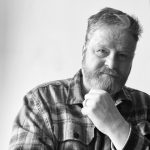What I Learned Cowriting A Novella
By Gareth L. Powell
In 2020, I had the privilege of cowriting a science fiction novella called Light Chaser with Peter F. Hamilton, author of more than twenty novels, including The Reality Dysfunction, Pandora’s Star, and Salvation.
If I had to break down the lessons I learned during this process into five key points, they would be:
- Choose a collaborator you respect and can trust to deliver.
Peter and I had run into each other at a number of conventions and launch events over the years, and interviewed each other in front of live audiences a few times. I think it may have been at one of these that I offhandedly suggested we collaborate on a story.
I had been reading and admiring Peter’s work since the late 1990s and knew he was prolific and imaginative and capable of telling a great story. I thought our different styles might complement each other. I had no expectation he would say yes, as I suspected he might be mired in the trenches of a novel deadline—but yes was what he said.
- Take time to discuss ideas and develop a shared vision.
As we both had other projects on the go, we decided to try and write a novella rather than a full novel. This meant that, if we divided the work equally, each of us would only have to write somewhere between 15,000 and 20,000 words, which didn’t seem too arduous.
We threw some ideas back and forth via email. I had an idea for a character, but no real story to go with it. Peter had some fascinating metaphysical ideas and fantastic settings. Slowly we considered and rejected several plot suggestions until we had something that we were both excited about, and something that would let us express the themes of the story, which were about social engineering and the enduring power of love.
- Break the story down into scenes or chapters, and decide who will write each one, so everyone knows what they are supposed to be doing.
Once we had a storyline, I travelled down to Somerset. In Peter’s study, we broke that storyline down into a number of scenes, decided who would write what and how each scene would connect with the other author’s thread. It was literally a case of sitting there saying, “You take that one, and I’ll take this one because I have a great idea for it.”
To keep the tone and pacing consistent, we decided not to write our sections independently. Rather, we would work on the same manuscript but take it in turns to add content.
- Let each writer play to their individual strengths.
Around half the story was set in the present day, with the main character on a starship travelling from world to world. The other half consisted of the recorded memories she was reviewing—memories culled from many individuals on different settled planets. As Peter is a consummate worldbuilder, he took charge of those latter scenes, while I played to my strength at writing complex lead characters.
Have you ever seen the children’s party game where the first child writes a sentence, then hands it to the second child to add the next, and so on? It was the same basic idea. Peter wrote a blistering first chapter featuring a starship the size of a skyscraper nose-diving into a star at a respectable fraction of the speed of light. He then sent it to me, and I read it with my mouth hanging open, realising (a) that it was the perfect opening, and (b) I was really going to have to write at the top of my game in order to match up.
So I began at the end of his section with a chapter of my own, introducing the main character and her world. I didn’t try to ape Peter’s style, but wrote it very much in my usual writing voice. Then I emailed it back.
We played tag like this over the next couple of months. Each time one of us received the updated manuscript, we’d read back over the new material and correct any glaring continuity errors. Then we’d write the next chapter and send it back.
Working like this was a fascinating, motivating experience. Not only was I witnessing a master at work, but the knowledge that he would be waiting for my next section kept me focused and determined to write my part as quickly and as well as possible, while still referring back to our original notes to ensure the tale remained on track.
- Leave your egos at the door.
When we finally reached the end of the story, we both took a turn at revising the manuscript for consistency. If there were changes to be made, we discussed them over email—and luckily, every suggestion made the story stronger.
People have asked me how we managed all this without falling prey to creative differences. Writing fiction can often be a solitary experience, and it can be hard to let someone into our imaginary worlds, especially if they start rearranging the furniture and repainting the walls.
But I think the main reason this methodology worked so well for us was that we didn’t feel the need to be competitive or precious about our sections. If Peter wanted to change something I had written, or vice versa, there was never any conflict—just a strong sense of joint ownership. We trusted each other’s judgement and abilities.
And finally…
Once the story was finished, our agents came to an agreement as to how they would jointly handle the submission and contract process, and sent the manuscript off to Lee Harris at Tordotcom.
And after all that, how was the book received? You’ll have to see my author bio for details…
 Gareth L. Powell is a British author known for using fast-paced, character-driven science fiction to explore big ideas and themes of identity, loss, and the human condition. He has twice won the coveted British Science Fiction Association Award for Best Novel, and has become one of the most-shortlisted authors in the award’s 50-year history. He has also been a finalist for the Locus, British Fantasy, and Seiun awards.
Gareth L. Powell is a British author known for using fast-paced, character-driven science fiction to explore big ideas and themes of identity, loss, and the human condition. He has twice won the coveted British Science Fiction Association Award for Best Novel, and has become one of the most-shortlisted authors in the award’s 50-year history. He has also been a finalist for the Locus, British Fantasy, and Seiun awards.
Light Chaser, cowritten with Peter F. Hamilton, appeared in paperback and ebook in 2021, and has been shortlisted for both the BSFA Award and the Canopus Award for Excellence in Interstellar Writing.
Gareth can be found online at www.garethlpowell.com.


